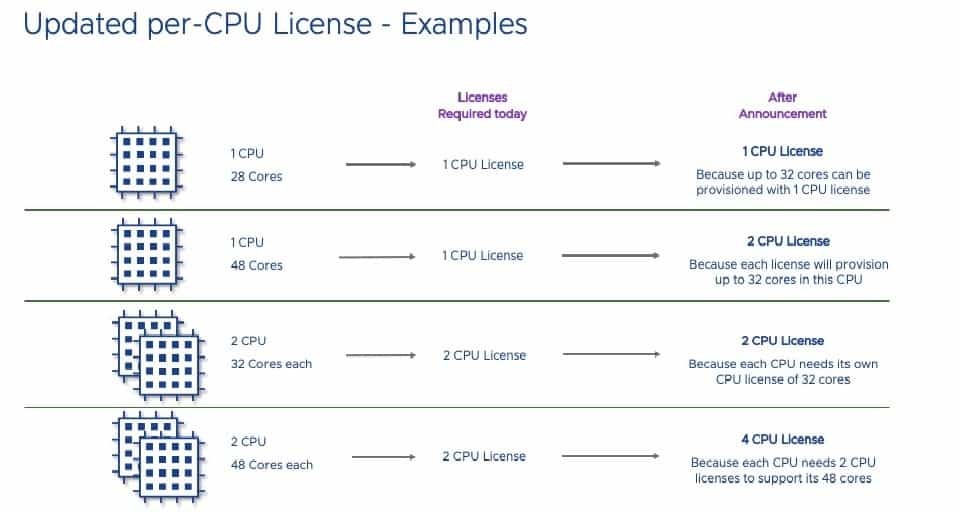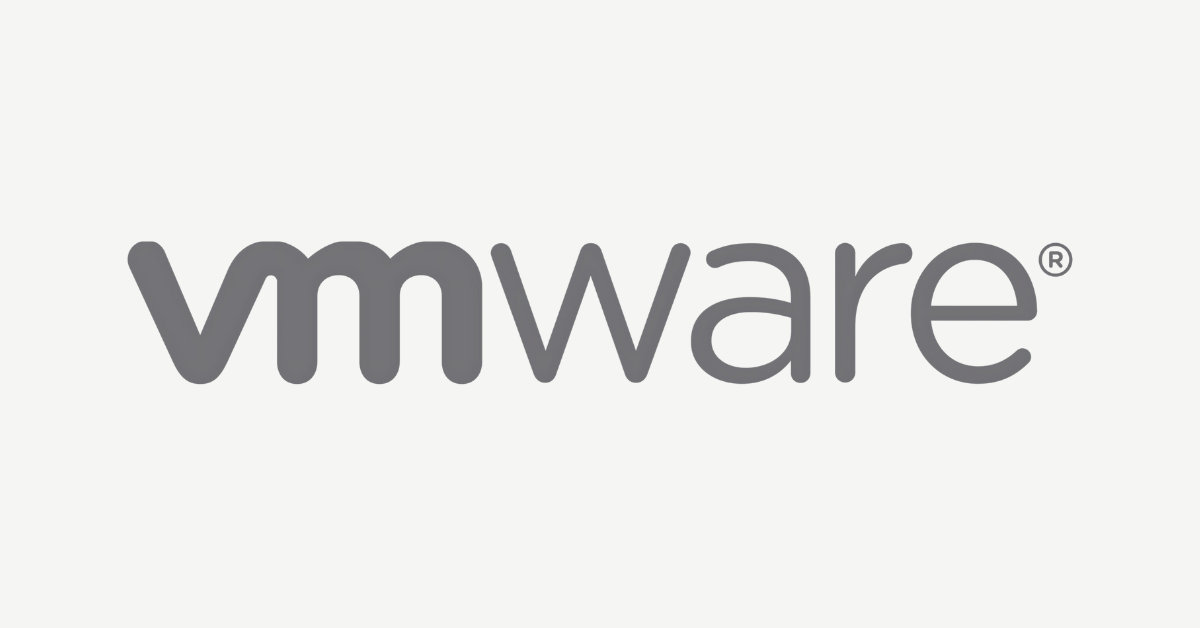VMware announced a significant change to its licensing per CPU. This entire change took effect on April 2, 2020.
Remembering before any technical analysis that the company has never been concerned with the number of cores in each CPU and so it must be the last of the major manufacturers to maintain a processor metric for physical CPUs. Most of them have already switched to licensing using more complex factors and indexes to calculate the required licenses.
This change can have an impact on the way your company provisions environments, on IT infrastructures and especially on how it plans to adopt hybrid clouds. Planning without taking into account public clouds or resources such as VMware Cloud on AWS could double the cost of CPU licensing for customers with more than 32 cores.
But what has changed?
In cases of processors running VMware with less than 32 cores, nothing changes. If these have more than 32, an extra license will be needed for the next 32 and additional licenses for each subsequent block of 32.

We know that AMD and Intel they already have chips with up to 64 cores, but it probably won't be long before we're talking about 96 or even 128 CPUs. It's worth mentioning that AWS, Google and Azure already have instances with 96 vCPUs.
How can I benefit from this change in VMware licensing now?
VMware is making a gradual move at no immediate cost, but to get this “benefit” you need to make some quick decisions and actions! If you don't make the changes now, the costs are bound to arrive in 2021.
Customers with CPUs above 32 cores per chip can request additional free licenses via a reseller or directly from VMware.
I canI will use this “benefit” if:
- Make the formal request for the benefit by January 29, 2021;
- If my servers and licenses were purchased before April 30, 2020. Please keep all hardware and software acquisition documents following the rules of Software Asset Management.
- I have a contract with SNS (VMware Technical Support and Subscription Services) active in the original licenses and contracted before April 30, 2020.
The burden of this benefit is that when you renew your support contract with VMware, you will normally be billed and supported for the additional free licenses you received under this “benefit”.
Our recommendation:
These changes in licensing rules can be managed by a Cloud and Software Governance Center of Excellence (CCoE). With a unified platform, you can control costs across your VMware datacenter as well as public clouds like AWS, Azure, and Google.
Many companies only consider the datacenter licensing architecture after migration, which can generate unexpected costs. Therefore, our methodology proposes that this study be carried out together with the technical architecture from the beginning.
Adopting the VMware subscription model, replacing perpetual licenses, requires strategic planning. Organizations need to optimize investments in VMware Cloud Foundation and other solutions, taking advantage of the benefits of the hybrid cloud.
For those seeking modernization, VMware Cloud is an efficient path. Running virtual machines, both on physical servers and bare metal, continues to be a cornerstone of IT strategy. Tools such as VMware Workstation Pro and Fusion Pro are essential for developing applications and creating flexible environments.
Integration with public clouds, such as Google Cloud VMware Engine, expands the possibilities, enabling VMware workloads to run in the cloud and accelerating digital transformation.
High availability and disaster recovery remain priorities. Solutions such as VMware vSAN and Cloud Foundation ensure business continuity and data protection. VMware Engine facilitates migration to the cloud with agility and scalability.
Finally, the ability to run different operating systems in VMs remains essential. VMware Workstation and Workstation Player offer flexibility for environments that rely on legacy applications.
The Changing VMware Licensing Model in the Age of AI
With the advancement of artificial intelligence and generative AI, the demand for high-performance computing resources is growing. VMware vSphere and VMware ESXi, together with VMware Cloud, provide the infrastructure needed to support these demanding workloads.
4MATT Tecnologia, with its expertise, helps companies navigate these changes, optimizing their investments in VMware Cloud and other solutions. Through a single hybrid cloud governance platform, it is possible to control the costs of the VMware datacenter and public clouds, ensuring efficient and strategic management of IT resources.
We believe that taking a proactive and strategic approach to licensing and infrastructure management is critical to success in the cloud computing era.
Broadcom VMware continues to support ESX, GSX Server and other products, ensuring legacy products remain operational while migrating to modern solutions. The ability to create virtual machines with advanced 3D graphics, along with virtual disk support, enables a rich and immersive user experience.
Implementing Virtual VDI on VMware
For organizations looking to implement Virtual VDI, VMware Cloud offers a robust and scalable platform that enables the delivery of high-performance and secure virtual desktops. VMware’s sales team is available to assist customers in selecting the best solutions for their needs, sharing customer stories and analyst reports that demonstrate the value and effectiveness of VMware solutions.
VMware Tools makes it easy to manage virtual environments, with support for SQL Server, Red Hat, and a partnership with Dell for broad infrastructure compatibility.
Implementing an efficient load balancer is crucial to ensuring high availability and performance of containerized and cloud-native applications. VMware Cloud offers advanced load balancing capabilities, enabling enterprises to optimize the use of their compute resources and ensure business continuity.
Vmware 2023: Acquisition by Broadcom
In 2023, Broadcom completed its acquisition of VMware for US$14.9 billion, marking one of the largest transactions in the technology sector in recent years. This merger directly impacted the company's corporate structure and product line, triggering a series of changes within the company. With the emergence of VMware by Broadcom, customers and partners had to quickly adapt to new market guidelines, especially regarding licensing and the continuity of established solutions such as VMware ESXi and vSphere.
VMware licensing changes in 2023
Transition to Subscription Models: Shortly after the acquisition, VMware announced that it would phase out perpetual licenses in December 2023 and move to subscription models. This change directly impacted widely used products such as vSphere and VMware Cloud Foundation, which are now only available through VMware subscription. The shift to recurring revenue requires companies to review their VMware licensing agreements, especially those with robust environments using VMware ESXi.
VMware Product Changes in 2024
Among the main changes in VMware 2024, the sale of the End User Computing (EUC) division to the KKR group, which renamed the unit Omnissa, stands out. In addition, the company surprised the market by releasing VMware Workstation Pro and Fusion Pro free of charge for personal use, configuring an initiative to get closer to developers and enthusiasts. The move reinforces Broadcom VMware's new positioning in relation to the product portfolio, while adding value to the brand and expanding access to solutions such as the free VMware Workstation.
Need help adapting your business to changes in VMware licensing? Talk to our experts and discover how to ensure efficiency and savings with Broadcom VMware's new subscription rules.


